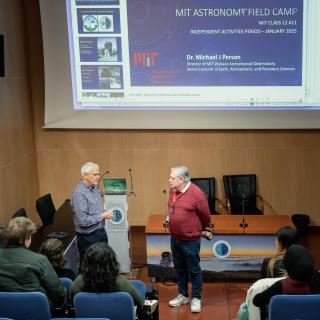The opening of the “II International Congress about Science with the Gran Telescpio CANARIAS (GTC): Science with the First Light Instruments and the Gran Telescopio Milimétrico (GTM),” organized by the Instituto de Astronomía de la Universidad Nacional Autónoma de México (IA-UNAM), Instituto Nacional de Astrofísica, Óptica y Electrónica de México (INAOE), with the participation of the Instituto de Astrofísica de Canarias (IAC) and GRANTECAN, the State Spanish business managing the construction of the GTC at the Roque de los Muchachos Observatory (Garafía, La Palma), was celebrated on Monday, February 16th in the Chapultepec Castle in Mexico City.
The ceremony was attended by Luciano Cedillo, Director of the Museo Nacional de Historia- Chapultepec Castle (Mexico); Stanley Dermott, Chairman of the Astronomy Department at the University of Florida; José Franco, Director of the IA-UNAM: Jorge Gil, Academic Coordination Secretary of Scientific Research of the UNAM: José Guichard, Director of the INAOE: Manuel Méndez Nonell, Adjunct Director of Science of the Consejo Nacional de Ciencia y Tecnología de México (CONACYT); and Francisco Sánchez, Director of the IAC.
“ The GTC and its First Light instruments are in their final construction stage, with a First Light expected in 2005,” commented José Franco in his presentation. “This supposes – he added – that the GTC’s scientific community must prepare for this telescope’s first year of operation; thus, the main goal of this meeting is to know the present state of the telescope and its First Light scientific instruments (OSIRIS and CanariCam) and to tackle the science that will be possible when the GTC is functioning.”
Moreover, due to the agreement between Mexico and Spain, in which a small portion of time of the GTM will be available to the Spanish Community, it is necessary to have previous knowledge about the science that will be done with both instruments, “especially now – said this researcher – that the Hubble Space Telescope is no longer financed by the United States Government, which will make our Earth-based instruments key elements in the study of the Universe.”
José Guichard mentioned that astronomy in Mexico is progressing very fast; thus, their involvement in various important projects, like the GTC and the GTM.
The GTM is a combined effort between the Instituto Nacional de Astrofísica, Óptica y Electrónica (INAOE) in Tonantzintla (México), and the University of Massachussets (UMass) in Amherst (United States).
It is a 50 m diameter antenna designed to pick up electromagnetic waves with a wavelength between 1 and 4 mm, called microwaves or millimetric waves. The telescope is being built on the summit of the Sierra Negra volcano, in the state of Puebla (Mexico). The site construction, along with the making of the majority of the antenna components, is at an advanced stage, estimating the completion of the telescope for this year, 2004.
Manuel Méndez, in his speech, reminded us that astronomy is one of the great cultural heritages of Mexico, and he emphasized the advances that have been developed in this area in the past years and the role that it has played and keeps playing in the boost it has given the other sciences.
In the press conference offered after the opening, Francisco Sánchez emphasized the importance of having Mexico and Florida as partners, due to the existing tradition in the study of Astronomy and Astrophysics in both places. He emphasized the boost that the GTC will be for new generations of scientists, of astronomers and technologists, and the importance of astronomy, which holds first place in the ranking of the sciences in Spain. Similarly, he emphasized the unique importance of the Canarian sky, which has been one of the major pillars of this boost in Spanish Astronomy, like being able to rely on an instrument like the GTC to continue in the vanguard of Astrophysics from an international perspective.
THE PROJECT
Driven by the Instituto de Astrofísica de Canarias (IAC), the Gran Telescopio CANARIAS (GTC) is the first project of such magnitude headed by Spain and located in its territory. Its construction is being carried out by the public enterprise “GRANTECAN,” created with the goal of gaining efficiency in the paperwork and production of the project and other preparatory plans and investments for its operation, for which the total cost was close to 112 million Euros.
The Comunidad Autónoma de Canarias and the General State Administration are partners of this enterprise. Moreover, the Instituto de Astronomía de la Universidad Nacional Autónoma de México (IA-UNAM), the Instituto Nacional de Astrofísica, Óptica y Electrónica (INAOE), and the Consejo Nacional de Ciencia y Tecnología de México (CONACYT), participate in the use and operation of the GTC with 5%, as well as the University of Florida (United States of America), which participates with the same percentage. In exchange, both countries will get observation time and are therefore integrated in the Committee for the Monitoring and Use of the GTC.
The use of the GTC will increase the knowledge about the origin and evolution of the Cosmos and will allow for the discovery of new and unknown phenomena in the Universe.


